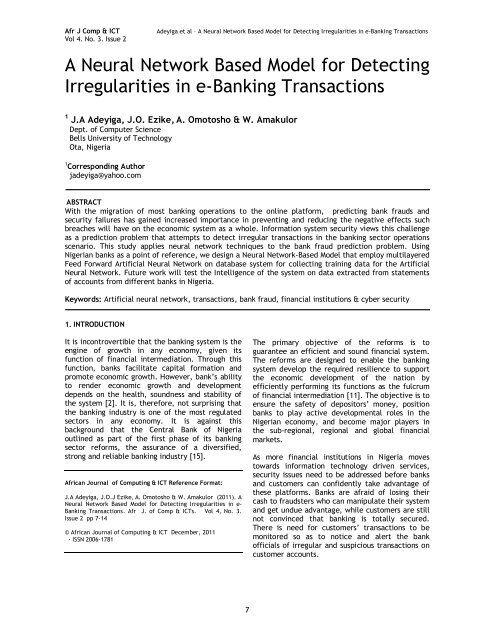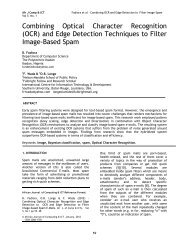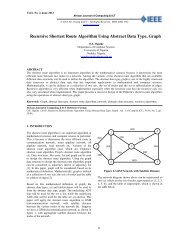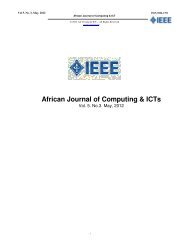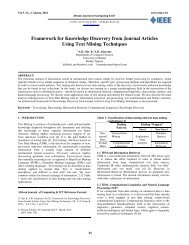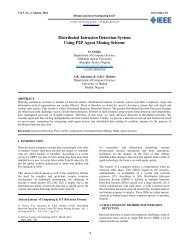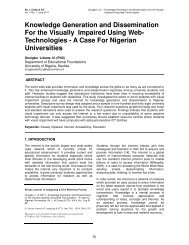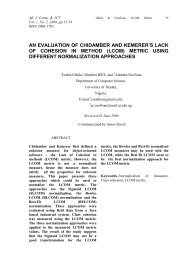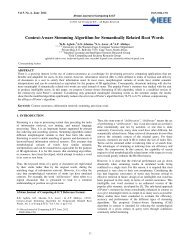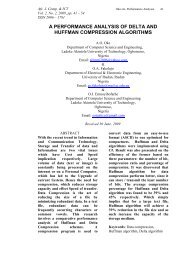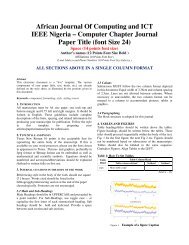A Neural Network Based Model for Detecting Irregularities in e ...
A Neural Network Based Model for Detecting Irregularities in e ...
A Neural Network Based Model for Detecting Irregularities in e ...
You also want an ePaper? Increase the reach of your titles
YUMPU automatically turns print PDFs into web optimized ePapers that Google loves.
Afr J Comp & ICTVol 4. No. 3. Issue 2Adeyiga et al – A <strong>Neural</strong> <strong>Network</strong> <strong>Based</strong> <strong>Model</strong> <strong>for</strong> <strong>Detect<strong>in</strong>g</strong> <strong>Irregularities</strong> <strong>in</strong> e-Bank<strong>in</strong>g TransactionsA <strong>Neural</strong> <strong>Network</strong> <strong>Based</strong> <strong>Model</strong> <strong>for</strong> <strong>Detect<strong>in</strong>g</strong><strong>Irregularities</strong> <strong>in</strong> e-Bank<strong>in</strong>g Transactions1 J.A Adeyiga, J.O. Ezike, A. Omotosho & W. AmakulorDept. of Computer ScienceBells University of TechnologyOta, Nigeria1 Correspond<strong>in</strong>g Authorjadeyiga@yahoo.comABSTRACTWith the migration of most bank<strong>in</strong>g operations to the onl<strong>in</strong>e plat<strong>for</strong>m, predict<strong>in</strong>g bank frauds andsecurity failures has ga<strong>in</strong>ed <strong>in</strong>creased importance <strong>in</strong> prevent<strong>in</strong>g and reduc<strong>in</strong>g the negative effects suchbreaches will have on the economic system as a whole. In<strong>for</strong>mation system security views this challengeas a prediction problem that attempts to detect irregular transactions <strong>in</strong> the bank<strong>in</strong>g sector operationsscenario. This study applies neural network techniques to the bank fraud prediction problem. Us<strong>in</strong>gNigerian banks as a po<strong>in</strong>t of reference, we design a <strong>Neural</strong> <strong>Network</strong>-<strong>Based</strong> <strong>Model</strong> that employ multilayeredFeed Forward Artificial <strong>Neural</strong> <strong>Network</strong> on database system <strong>for</strong> collect<strong>in</strong>g tra<strong>in</strong><strong>in</strong>g data <strong>for</strong> the Artificial<strong>Neural</strong> <strong>Network</strong>. Future work will test the Intelligence of the system on data extracted from statementsof accounts from different banks <strong>in</strong> Nigeria.Keywords: Artificial neural network, transactions, bank fraud, f<strong>in</strong>ancial <strong>in</strong>stitutions & cyber security1. INTRODUCTIONIt is <strong>in</strong>controvertible that the bank<strong>in</strong>g system is theeng<strong>in</strong>e of growth <strong>in</strong> any economy, given itsfunction of f<strong>in</strong>ancial <strong>in</strong>termediation. Through thisfunction, banks facilitate capital <strong>for</strong>mation andpromote economic growth. However, bank’s abilityto render economic growth and developmentdepends on the health, soundness and stability ofthe system [2]. It is, there<strong>for</strong>e, not surpris<strong>in</strong>g thatthe bank<strong>in</strong>g <strong>in</strong>dustry is one of the most regulatedsectors <strong>in</strong> any economy. It is aga<strong>in</strong>st thisbackground that the Central Bank of Nigeriaoutl<strong>in</strong>ed as part of the first phase of its bank<strong>in</strong>gsector re<strong>for</strong>ms, the assurance of a diversified,strong and reliable bank<strong>in</strong>g <strong>in</strong>dustry [15].African Journal of Comput<strong>in</strong>g & ICT Reference Format:J.A Adeyiga, J.O.J Ezike, A. Omotosho & W. Amakulor (2011). A<strong>Neural</strong> <strong>Network</strong> <strong>Based</strong> <strong>Model</strong> <strong>for</strong> <strong>Detect<strong>in</strong>g</strong> <strong>Irregularities</strong> <strong>in</strong> e-Bank<strong>in</strong>g Transactions. Afr J. of Comp & ICTs. Vol 4, No. 3.Issue 2 pp 7-14© African Journal of Comput<strong>in</strong>g & ICT December, 2011- ISSN 2006-1781The primary objective of the re<strong>for</strong>ms is toguarantee an efficient and sound f<strong>in</strong>ancial system.The re<strong>for</strong>ms are designed to enable the bank<strong>in</strong>gsystem develop the required resilience to supportthe economic development of the nation byefficiently per<strong>for</strong>m<strong>in</strong>g its functions as the fulcrumof f<strong>in</strong>ancial <strong>in</strong>termediation [11]. The objective is toensure the safety of depositors’ money, positionbanks to play active developmental roles <strong>in</strong> theNigerian economy, and become major players <strong>in</strong>the sub-regional, regional and global f<strong>in</strong>ancialmarkets.As more f<strong>in</strong>ancial <strong>in</strong>stitutions <strong>in</strong> Nigeria movestowards <strong>in</strong><strong>for</strong>mation technology driven services,security issues need to be addressed be<strong>for</strong>e banksand customers can confidently take advantage ofthese plat<strong>for</strong>ms. Banks are afraid of los<strong>in</strong>g theircash to fraudsters who can manipulate their systemand get undue advantage, while customers are stillnot conv<strong>in</strong>ced that bank<strong>in</strong>g is totally secured.There is need <strong>for</strong> customers’ transactions to bemonitored so as to notice and alert the bankofficials of irregular and suspicious transactions oncustomer accounts.7
Afr J Comp & ICTVol 4. No. 3. Issue 2Adeyiga et al – A <strong>Neural</strong> <strong>Network</strong> <strong>Based</strong> <strong>Model</strong> <strong>for</strong> <strong>Detect<strong>in</strong>g</strong> <strong>Irregularities</strong> <strong>in</strong> e-Bank<strong>in</strong>g TransactionsCurrently, transactions are usually manuallymonitored by bank personnel who look through thecustomers’ statement of accounts when unusualtransactions are noticed. The process is often verytedious and <strong>in</strong>efficient ma<strong>in</strong>ly because of thenumber of transactions and customer base.With the advent of computers and In<strong>for</strong>mationsystems there is a possibility of an automatedapproach to the analysis of the customers’statement of account <strong>for</strong> detect<strong>in</strong>g irregularities <strong>in</strong>bank<strong>in</strong>g activities. However, consider<strong>in</strong>g the fastpace at which ma<strong>in</strong>stream bus<strong>in</strong>ess rules changes,the def<strong>in</strong>ition of fraudulent transaction changesrapidly thereby mak<strong>in</strong>g the design anddevelopment of such a system a rather complexprocess [1]. A solution paradigm is to exploreautomated approaches to irregularity detectionus<strong>in</strong>g algorithmic approach and artificial IntelligentSystem.2. RELATED WORKSIn [7][12] an approach to fraud detection that isbased on track<strong>in</strong>g call<strong>in</strong>g behaviour on an accountover time and scor<strong>in</strong>g calls accord<strong>in</strong>g to the extentthat they deviate from patterns that resemblefraud are described. Account summaries arecompared to threshold each period and an accountwhose summary exceeds a threshold can be queuedto be analyzed <strong>for</strong> fraud. Threshold<strong>in</strong>g has severaldisadvantages; it may vary with time of day, typeof account and types of call to be sensitive to fraud<strong>in</strong>vestigation without sett<strong>in</strong>g off too many falsealarms <strong>for</strong> legitimate traffic [12].Fawcett and Provost [7] developed an <strong>in</strong>novativemethod <strong>for</strong> choos<strong>in</strong>g account-specific thresholdrather than universals threshold that apply to allaccounts or all accounts <strong>in</strong> a segment. In theexperiment, fraud detection is based on track<strong>in</strong>gaccount behaviour. Fraud detection was eventdriven and not time driven, so that fraud can bedetected as it is happen<strong>in</strong>g. Second, frauddetection must be able to learn the call<strong>in</strong>g patternon an account and adapt to legitimate changes <strong>in</strong>call<strong>in</strong>g behaviour. Lastly, fraud detection must beself-<strong>in</strong>itializ<strong>in</strong>g so that it can be applied to newaccounts that do not have enough data <strong>for</strong> tra<strong>in</strong><strong>in</strong>g.The approach adopted probability distributionfunctions to track legitimate call<strong>in</strong>g behaviour.In [4] it was stated that that many f<strong>in</strong>ancial<strong>in</strong>stitutions see the value of ANNs as a support<strong>in</strong>gmechanism <strong>for</strong> f<strong>in</strong>ancial analysts and are actively<strong>in</strong>vest<strong>in</strong>g <strong>in</strong> this arena. The models describedprovide the needed knowledge to choose the typeof neural network to be used. The use oftechniques of decision trees, <strong>in</strong> conjunction withthe management model CRISP-DM, to help <strong>in</strong> theprevention of bank fraud was evaluated <strong>in</strong> {5}. Thestudy recognized the fact that it is almostimpossible to eradicate bank fraud and focused onwhat can be done to m<strong>in</strong>imize frauds and preventthem. The research offered a study on decisiontrees, an important concept <strong>in</strong> the field ofartificial <strong>in</strong>telligence. The study focused ondiscuss<strong>in</strong>g how these trees are able to assist <strong>in</strong> thedecision mak<strong>in</strong>g process of identify<strong>in</strong>g frauds bythe analysis of <strong>in</strong><strong>for</strong>mation regard<strong>in</strong>g banktransactions. This <strong>in</strong><strong>for</strong>mation is captured with theuse of techniques and the CRISP-DM managementmodel of data m<strong>in</strong><strong>in</strong>g <strong>in</strong> large operationaldatabases logged from <strong>in</strong>ternet bank.The Cross Industry Standard Process <strong>for</strong> Data-M<strong>in</strong><strong>in</strong>g – CRISP-DM is a model of a data m<strong>in</strong><strong>in</strong>gprocess used to solve problems by experts. Themodel identifies the different stages <strong>in</strong>implement<strong>in</strong>g a data m<strong>in</strong><strong>in</strong>g project while, Adecision tree is both a data represent<strong>in</strong>g structureand a method used <strong>for</strong> data m<strong>in</strong><strong>in</strong>g and mach<strong>in</strong>elearn<strong>in</strong>g. [3] describes the Use of neural networks<strong>in</strong> analyz<strong>in</strong>g the great <strong>in</strong>crease <strong>in</strong> credit cardtransactions; credit card fraud has become<strong>in</strong>creas<strong>in</strong>gly rampant <strong>in</strong> recent years. This study<strong>in</strong>vestigates the efficacy of apply<strong>in</strong>g classificationmodels to credit card fraud detection problems.Three different classification methods, i.e.decision tree, neural networks and logisticregression were tested <strong>for</strong> their applicability <strong>in</strong>fraud detections. The paper provides a usefulframework to choose the best model to recognizethe credit card fraud risk. <strong>Detect<strong>in</strong>g</strong> credit cardfraud is a difficult task when us<strong>in</strong>g normalprocedures, so the development of the credit cardfraud detection model has become of significance,whether <strong>in</strong> the academic or bus<strong>in</strong>ess communityrecently. These models are mostly statistics-drivenor artificial <strong>in</strong>telligent-based, which have thetheoretical advantages <strong>in</strong> not impos<strong>in</strong>g arbitraryassumptions on the <strong>in</strong>put variables.Other models that have been developed <strong>in</strong>research sett<strong>in</strong>gs that have promis<strong>in</strong>g potential <strong>for</strong>real world applications <strong>in</strong>clude the CustomerRelationship <strong>Model</strong>, Bankruptcy Prediction <strong>Model</strong>,Inventory Management <strong>Model</strong>, and F<strong>in</strong>ancial Market<strong>Model</strong>.8
Afr J Comp & ICTVol 4. No. 3. Issue 2Adeyiga et al – A <strong>Neural</strong> <strong>Network</strong> <strong>Based</strong> <strong>Model</strong> <strong>for</strong> <strong>Detect<strong>in</strong>g</strong> <strong>Irregularities</strong> <strong>in</strong> e-Bank<strong>in</strong>g TransactionsTo <strong>in</strong>crease the body of knowledge on this subject,an <strong>in</strong>-depth exam<strong>in</strong>ation of important publiclyavailable predictors of fraudulent f<strong>in</strong>ancialstatements was offered. They tested the value ofthese suggested variables <strong>for</strong> detection offraudulent f<strong>in</strong>ancial statements with<strong>in</strong> a matchedpair’s sample. Self-organiz<strong>in</strong>g Artificial <strong>Neural</strong><strong>Network</strong> (ANN) AutoNet was used <strong>in</strong> conjunctionwith standard statistical tools to <strong>in</strong>vestigate theusefulness of these publicly available predictors.The study resulted <strong>in</strong> a model with a highprobability of detect<strong>in</strong>g fraudulent f<strong>in</strong>ancialstatements on one sample[1][6]. The studyre<strong>in</strong><strong>for</strong>ced the validity and efficiency of AutoNet asa research tool and provides additional empiricalevidence regard<strong>in</strong>g the merits of suggested redflags <strong>for</strong> fraudulent f<strong>in</strong>ancial statements. [10]Reviews the various factors that lead to fraud <strong>in</strong>the Nigerian Bank<strong>in</strong>g <strong>in</strong>dustry. The problem offraud <strong>in</strong> our bank<strong>in</strong>g system may have someattachment. There<strong>for</strong>e, there must be somefactors that may have led to this fraudulent act.The problems are stated below:Bank malpracticesi. Failure to appo<strong>in</strong>t trusted and honest officialas the banks representative <strong>in</strong> the clear<strong>in</strong>ghouseii. Failure to change representative on regularbasisiii. Failure to provide locked boxes or bags <strong>for</strong>carry<strong>in</strong>g cheques to and from the central banksiv. Inadequate tra<strong>in</strong><strong>in</strong>g facilities <strong>for</strong> clear<strong>in</strong>g staffboth <strong>in</strong> the offices and central bankv. Negligence <strong>in</strong> check<strong>in</strong>g clear<strong>in</strong>g cheques fromthe banks to avoid a case of possible shortchange of chequeThis study is important due to the variousguidel<strong>in</strong>es that can be drawn <strong>in</strong> com<strong>in</strong>g up with asolution based on the problems listed above.3. METHODOLOGYWe perceive neural networks as tools that canrecall and learn patterns of behaviour, detectchanges <strong>in</strong> patterns, and detect fraud <strong>in</strong> a paymentcard environment. We research to do thefollow<strong>in</strong>g:• Generate/ create a unique network <strong>for</strong>each account <strong>in</strong> the bank• Generate patterns <strong>for</strong> the network us<strong>in</strong>gthe client history.• Tra<strong>in</strong> the network at user def<strong>in</strong>ed epochvalue or till there error value isapproximately 0.• Once the network has learned, feeds thecurrent transaction <strong>in</strong>to the network toknow if it is a fraud or not.Components of The Irregularity Detection Systemi. <strong>Neural</strong> network based detectorii. Databaseiii. Computer System3.1.1 <strong>Neural</strong> <strong>Network</strong> <strong>Based</strong> DetectorThe neural network based detector is amathematical model or computational model basedon biological neural networks, <strong>in</strong> other words, it isan emulation of biological neural system. A neuralnetwork is a massively parallel distributedprocessor that has a natural propensity <strong>for</strong> stor<strong>in</strong>gexperiential knowledge and mak<strong>in</strong>g it available <strong>for</strong>use. It resembles the bra<strong>in</strong> <strong>in</strong> two respects [8].1. Knowledge is acquired by the network through alearn<strong>in</strong>g process.2. Interconnection strengths known as synapticWeights are used to store the knowledge.3.1.2 DatabaseThe data are typically organized to model relevantaspects of reality. Structured query language willbe used <strong>for</strong> the data store. This is the region wherethe account statements will be lodged and detailsof all transactions that take place <strong>in</strong> each accountare stored <strong>in</strong> the database.All transactions carried out <strong>in</strong> a customer’s accountare stored <strong>in</strong> the database and can be retrievedwhen needed. The database serves as theknowledge base to the neural network, thenetwork tra<strong>in</strong>s and generates results based on the<strong>in</strong><strong>for</strong>mation <strong>in</strong> the knowledge base.3.1.3 Computer SystemThe Computer system consists of the plat<strong>for</strong>m <strong>in</strong>which the irregularity detection system willoperate, neural network cannot exist on its own. Itis usually implemented <strong>in</strong> computer systems andrelated devices. The computer also serves as the<strong>in</strong>terface between the neural network baseddetector and the system user. The computerpresents the <strong>in</strong>put data (user query) to the neuralnetwork.9
Afr J Comp & ICTVol 4. No. 3. Issue 2Adeyiga et al – A <strong>Neural</strong> <strong>Network</strong> <strong>Based</strong> <strong>Model</strong> <strong>for</strong> <strong>Detect<strong>in</strong>g</strong> <strong>Irregularities</strong> <strong>in</strong> e-Bank<strong>in</strong>g Transactions3.2 Layout of the Irregularity DetectionSystemThe simplified activities that take place <strong>in</strong> theirregularity detection system1. The <strong>in</strong>put data (customer credit/debittransaction) is presented by the <strong>in</strong>terface(computer) to the database (knowledgebase).2. The network is fed by the knowledge base.3. The network tra<strong>in</strong>s based on the data <strong>in</strong>the knowledge base4. If the network based detector detects anyirregularity, the transaction is disallowedelse the transaction is allowed. Whateverdecision the network based detectorarrives at is stored at the knowledge base(database)Figure 2. Proposed System <strong>Model</strong>3.3 The <strong>Network</strong> Tra<strong>in</strong><strong>in</strong>g <strong>Model</strong><strong>Model</strong><strong>in</strong>g was done us<strong>in</strong>g the unified model<strong>in</strong>glanguage (UML). The system is modeled to be ableto look through a client’s transaction history andgenerate an <strong>in</strong>telligent pattern which will be usedas standard <strong>for</strong> test<strong>in</strong>g the next transaction.Figure 1. Proposed System componentsFor example consideri. A client that has made withdrawals about1000 times from a particular branch of abank is suddenly withdraw<strong>in</strong>g from afarther (another) branch.ii. A client transaction history can denote hismaximum withdrawal/Deposit to be 5000naira, and suddenly he/shewithdraws/deposits 5,000,000 naira.iii. A client withdrawal/deposit mode andtransaction date difference can also beused as a po<strong>in</strong>ter <strong>in</strong> identify<strong>in</strong>girregularities.In tra<strong>in</strong><strong>in</strong>g the multilayer perceptron network(MLP), five different entries will be <strong>in</strong>putted whichare as follows;Entry 1 : difference between the currentand last transaction based on the number of days.Entry 2: percentage of last withdrawal/deposit tocurrent transaction10
Afr J Comp & ICTVol 4. No. 3. Issue 2Adeyiga et al – A <strong>Neural</strong> <strong>Network</strong> <strong>Based</strong> <strong>Model</strong> <strong>for</strong> <strong>Detect<strong>in</strong>g</strong> <strong>Irregularities</strong> <strong>in</strong> e-Bank<strong>in</strong>g TransactionsEntry 3: the branch the transaction is tak<strong>in</strong>g place(location)Entry 4: patron that is; self or different person?Entry 5: transaction date.The network produces reasonable outputs <strong>for</strong><strong>in</strong>puts it has not been taught how to deal with. Thevarious entries are presented to the network <strong>in</strong><strong>for</strong>m of numeric values. Transaction mode <strong>for</strong>withdrawal can only be either cheque/slip, ATM,Credit Card. These values can only be presentedwith numeric values <strong>in</strong> order to generate a pattern.Fixed numbers are chosen at random with thecondition of be<strong>in</strong>g centralized around zero. Thenumbers are chosen <strong>in</strong> order to have dist<strong>in</strong>ctiveoutput when presented to the network. Theserandom values assist <strong>in</strong> reduc<strong>in</strong>g the learn<strong>in</strong>g timeof the MLP else the network might take a longertime to learn (tra<strong>in</strong><strong>in</strong>g a <strong>Neural</strong> <strong>Network</strong> <strong>in</strong>volvestrial an error till the result generated matches thetarget output).The same process is followed <strong>for</strong> branches thougheach branch a bank is uniquely identified by codes.Random values between -1 and +1 are used torepresent the parameters. MLP learns well withvalues cantered on zero. The amount <strong>in</strong>volved <strong>in</strong>the transaction is represented as the percent ofthe last transaction amount to the currenttransaction amount; the date is captured by thesystem based on the system’s calendar and clock.The tra<strong>in</strong><strong>in</strong>g process and algorithm is thusdescribed below;3.4 The Tra<strong>in</strong><strong>in</strong>g AlgorithmSupervised Back propagation tra<strong>in</strong><strong>in</strong>g algorithm wasused to tra<strong>in</strong> the neural network because of itseffectiveness towards pattern recognition. Tra<strong>in</strong><strong>in</strong>gset is a collection of tra<strong>in</strong><strong>in</strong>g samples gathered. Atra<strong>in</strong><strong>in</strong>g sample is a pair of <strong>in</strong>put vector plus adesired output value (0.8 or -0.8). The networkwas provided with the tra<strong>in</strong><strong>in</strong>g set and allow<strong>in</strong>g itto learn by adjust<strong>in</strong>g weights of its synapses byback propagat<strong>in</strong>g the error calculated as thedisparity between the output neuron to theexpected/target value.3.5 The Actual Algorithm1. Identify number of <strong>in</strong>put neurons (same asnumber of elements <strong>in</strong> the <strong>in</strong>put vector)2. Identify number of hidden layers andnumber of neurons on each layer.(M<strong>in</strong>imum required <strong>for</strong> back propagation isone hidden layer but <strong>for</strong> faster tra<strong>in</strong><strong>in</strong>g weused two hidden layers each with 10neurons each).3. Identify number of output neurons. Weused one neuron on the output layerbecause we have one target value.4. Initialize random weight values <strong>for</strong> thesynapses connect<strong>in</strong>g each neurons ofpreced<strong>in</strong>g layer to the next layer. Withback propagation, weight values should berestricted to between -0.5 and +0.5.5. Choose a random tra<strong>in</strong><strong>in</strong>g set from thetra<strong>in</strong><strong>in</strong>g sample and assign <strong>in</strong>put vector tothe <strong>in</strong>put neurons.6. Propagate all neurons <strong>in</strong> the <strong>for</strong>warddirection to obta<strong>in</strong> output at the outputlayer.a) The output of each neuron is afunction of its <strong>in</strong>puts. In particular,the output of the jth neuron <strong>in</strong> anylayer is described by two sets ofequations on the right: Uj = ∑ (Xi .wij)…………………….(1)b) For every neuron, j, <strong>in</strong> a layer,each of the i <strong>in</strong>puts, X i , to that Yj =Fth (Uj + tj) layer is multiplied by apreviously established weight, w ij .These are all summed together,result<strong>in</strong>g <strong>in</strong> the <strong>in</strong>ternal value ofthis operation, U j . This value isthen biased by a previouslyestablished threshold value, t j , andsent through an activationfunction, F th (tanh function).c) The result<strong>in</strong>g output, Y j , is an <strong>in</strong>putto the next layer or it is a responseto the neural network if it is thelast layer.7. Evaluate error values at the output neuronas the difference between obta<strong>in</strong>ed outputand the desired output of the tra<strong>in</strong><strong>in</strong>g setchosen.8. Backpropagate the error, all the way up tothe <strong>in</strong>put layer.a. Back propagation starts from theoutput layer with the follow<strong>in</strong>gequation.Ѡij =ԝij + LR . ej .Xi………………………….(2)11
Afr J Comp & ICTVol 4. No. 3. Issue 2Adeyiga et al – A <strong>Neural</strong> <strong>Network</strong> <strong>Based</strong> <strong>Model</strong> <strong>for</strong> <strong>Detect<strong>in</strong>g</strong> <strong>Irregularities</strong> <strong>in</strong> e-Bank<strong>in</strong>g Transactionsb. For the <strong>in</strong>put of neuron <strong>in</strong> theoutput layer, the weight w isadjusted by add<strong>in</strong>g to the previousweight value, w' ij , a termdeterm<strong>in</strong>ed by the product of alearn<strong>in</strong>g rate, LR, an error term,e j , and the value of the <strong>in</strong>put, X i .The error term, e j , <strong>for</strong> the outputneuron is determ<strong>in</strong>ed by theproduct of the actual output, Y j ,its complement, 1 - Y j , and thedifference between the desiredoutput, d j , and the actual output.Ej = Yj . (1 - Yj) . (dj - Yj)………………………..(3)9. Calculate and update weight values <strong>for</strong> allsynapses such that the sum squared valueof the error are m<strong>in</strong>imized.a. Once the error term is computedand weights are adjusted <strong>for</strong> theoutput layer, the value is recordedand the next layer back isadjusted. A revised weightadjustment process was adopted<strong>for</strong> updat<strong>in</strong>g the weights follow<strong>in</strong>gthe Equation below.Ⱳij = w’ij + (1 - M) ˑLR ˑ ej ˑ Xj + M ˑ (w'ij -wʹʹij)….(4)Momentum (M) basically allows a change to theweights to persist <strong>for</strong> a number of adjustmentcycles. The magnitude of the persistence iscontrolled by the momentum factor. If themomentum factor is set to 0, then the equationreduces to that used to adjust the weight of theoutput layer. If the momentum factor is <strong>in</strong>creasedfrom 0, <strong>in</strong>creas<strong>in</strong>gly greater persistence ofprevious adjustments is allowed <strong>in</strong> modify<strong>in</strong>g thecurrent adjustment. This can improve the learn<strong>in</strong>grate <strong>in</strong> some situations, by help<strong>in</strong>g to smooth outunusual conditions <strong>in</strong> the tra<strong>in</strong><strong>in</strong>g set.12. Stopp<strong>in</strong>g criterion is until the errorobta<strong>in</strong>ed at the output layer is at anacceptable value. (0.02)3.6 The Transfer Functions of the <strong>Neural</strong><strong>Network</strong>.Activation function is used to obta<strong>in</strong> output fromeach neuron. Tangential Activation function wasadopted.The equation is Y=tanh(x).Input nodes shall be presented which are expectedto yield a target output.If the output is not correct, the weights areadjusted accord<strong>in</strong>g to the <strong>for</strong>mula:w new = w old + α(desired – output)*<strong>in</strong>put……………(6)where α is the learn<strong>in</strong>g rate (Cheung and Cannons,2002)Us<strong>in</strong>g tanh activation function on all neurons thenetwork, the output of each neuron rangesbetween -1 and +1. Some tra<strong>in</strong><strong>in</strong>g set <strong>in</strong> thetra<strong>in</strong><strong>in</strong>g sample has a target value of 0.8 and some-0.8.Once the error at the output layer is at anacceptable level, the test data is fed <strong>in</strong>to thenetwork from the <strong>in</strong>put layer and the output valueis derived. The sensitivity bar ranges from -0.8 to0.8 although presented to range from 0 to 100%.The transaction is committed if the output of thetest data is greater than the value of the sensitivitybar, otherwise rolled back.b. The error term is generated by aslightly modified version ofEquation <strong>in</strong> steps 9 above. Thismodification is:ej = Yj ˑ (1 - Yj) ˑ ∑ (℮k ˑ Ⱳʹjk)…………………….(5)10. Choose another random tra<strong>in</strong><strong>in</strong>g set <strong>for</strong>mthe tra<strong>in</strong><strong>in</strong>g sample and repeat the stepsabove.11. Tra<strong>in</strong> all tra<strong>in</strong><strong>in</strong>g set <strong>in</strong> the tra<strong>in</strong><strong>in</strong>g sample<strong>in</strong> a random selection order. A cyclethrough the tra<strong>in</strong><strong>in</strong>g sample is called anepoch.Figure 3. An illustration of the tra<strong>in</strong><strong>in</strong>g sets <strong>for</strong>the multilayer perceptron network.Source: (Werbos [16]; Rumelhart [14])12
Afr J Comp & ICTVol 4. No. 3. Issue 2Adeyiga et al – A <strong>Neural</strong> <strong>Network</strong> <strong>Based</strong> <strong>Model</strong> <strong>for</strong> <strong>Detect<strong>in</strong>g</strong> <strong>Irregularities</strong> <strong>in</strong> e-Bank<strong>in</strong>g Transactions3.7 Tra<strong>in</strong><strong>in</strong>g and VerificationThe tra<strong>in</strong><strong>in</strong>g set is not fixed based on all previoustransactions with the bank. The tra<strong>in</strong><strong>in</strong>g set(<strong>in</strong>itials tra<strong>in</strong><strong>in</strong>g set) is 70% of the previoustransactions while the test<strong>in</strong>g set (cross validation<strong>in</strong> the tra<strong>in</strong><strong>in</strong>g process) is 30% of the transactions.Cross validation patterns are a fraction of theclient history not used <strong>for</strong> tra<strong>in</strong><strong>in</strong>g rather to checkif the network has learned, the error ratio (crossvalidation error) is shown be<strong>for</strong>e tra<strong>in</strong><strong>in</strong>g.The function of the current transaction is there<strong>for</strong>eto test aga<strong>in</strong>st the neural network to determ<strong>in</strong>e itsper<strong>for</strong>mance.A sensitivity bar will be <strong>in</strong>cluded so thattransactions with values head<strong>in</strong>g towards acceptedlevel that should be suspicious will not besuccessful. The tra<strong>in</strong><strong>in</strong>g set is the set of all knownsamples is broken <strong>in</strong>to two orthogonal(<strong>in</strong>dependent) sets:1. Tra<strong>in</strong><strong>in</strong>g set 1: A group of samples used totra<strong>in</strong> the neural network2. Test<strong>in</strong>g set 2: A group of samples used totest the per<strong>for</strong>mance of the neuralnetwork. It is also used to estimate theerror rateVerification;i. Provides an unbiased test of the quality ofthe networkii. Common error is to “test” the neuralnetwork us<strong>in</strong>g the same samples that wereused to tra<strong>in</strong> the neural network.<strong>Based</strong> on the test<strong>in</strong>g set;1. The network is optimized based on thesesamples, and will obviously per<strong>for</strong>m wellon them.2. Verification doesn’t give any <strong>in</strong>dication asto how well the network will be able toclassify <strong>in</strong>puts that weren’t <strong>in</strong> the tra<strong>in</strong><strong>in</strong>gsetEpochThis is basically the number of times the neuralnetwork should tra<strong>in</strong> <strong>for</strong> a particular transaction.i. One iteration through the process ofprovid<strong>in</strong>g the network with an <strong>in</strong>put andupdat<strong>in</strong>g the network's weights.ii. The amount of epochs needed <strong>for</strong> theneural network is not fixed. Typically manyepochs are required to tra<strong>in</strong> the neuralnetwork.<strong>Irregularities</strong> detected by the system based on thetra<strong>in</strong><strong>in</strong>g set provided to it will be made known tothe bank official, it then becomes the duty of thebank officials to decide if such transactions shouldcont<strong>in</strong>ue or be discont<strong>in</strong>ued.4. CONCLUSIONIn this work, the irregularity detection system<strong>Model</strong> has sought to reduce the risk level offraudulent transactions that take place <strong>in</strong> theNigerian bank<strong>in</strong>g <strong>in</strong>dustry thereby aid<strong>in</strong>g <strong>in</strong> thedecrement of bank fraud. This will br<strong>in</strong>gs aboutreduced fraudulent transactions if implementedproperly. <strong>Neural</strong> network technology is appropriate<strong>in</strong> detect<strong>in</strong>g fraudulent transactions because of itsability to learn and remember the characteristicsof the fraudulent transactions and apply that“knowledge” when assess<strong>in</strong>g new transactions.REFERENCES[1] Idowu, A., “An Assessment of Fraud and itsManagement <strong>in</strong> Nigeria Commercial Banks”.European Journal of Social Sciences. Vol. 10, No4.,2009, pp 628-640,[2] Adeyemi, k,“Bank<strong>in</strong>g Sector consolidation <strong>in</strong>Nigeria: issues and challenges”,2005. Retrievedfrom www.unionbankng.com[3] Aihua Shen, Rencheng Tong, Yaochen Deng,(2007). “Application of classification <strong>Model</strong>s onCredit Card fraud detection.” Service Systemsand Service Management, 2007 InternationalConference on 07/2007; DOI:10.1109/ICSSSM.2007.4280163[4] Amit Khajanchi.. “Artificial <strong>Neural</strong> <strong>Network</strong>s:The next <strong>in</strong>telligence”,2003,. Available atwww.globalriskguard.com/resources/market/NN.pdf[5] Bruno Carneiro, Rafael Sousa, “Identify<strong>in</strong>gBanks Fraud Us<strong>in</strong>g CRISP-DM and DecisionTrees.” International Journal of ComputerScience and In<strong>for</strong>mation Technology (IJCSIT)Vol.2, No.5, October 2010.[6] Fann<strong>in</strong>g. K, Cogger. K. O and Srivastava. R.“Detection of management fraud: A neuralnetwork approach” International Journal ofIntelligent Systems <strong>in</strong> Account<strong>in</strong>g, F<strong>in</strong>ance andManagement .1995. 4 113-126.[7] Fawcett, T. and Provost, F. “Adaptive frauddetection”. Data M<strong>in</strong><strong>in</strong>g and knowledgeDiscovery,1997. 1:291-316[8] Hayk<strong>in</strong>, S , “<strong>Neural</strong> <strong>Network</strong>s; A ComprehensiveFoundation”, 2nd ed. (Englewood Cliffs, NJ:Prentice-Hall). 1999.13
Afr J Comp & ICTVol 4. No. 3. Issue 2Adeyiga et al – A <strong>Neural</strong> <strong>Network</strong> <strong>Based</strong> <strong>Model</strong> <strong>for</strong> <strong>Detect<strong>in</strong>g</strong> <strong>Irregularities</strong> <strong>in</strong> e-Bank<strong>in</strong>g Transactions[9] Idolor Eseoghene Joseph .”BANK FRAUDS INNIGERIA”; underly<strong>in</strong>g causes, effects andpossible remedies”. African Journal ofAccount<strong>in</strong>g, Economics, F<strong>in</strong>ance and Bank<strong>in</strong>gResearch Vol. 6.No. 6. 2010.[10] Ivor Ogidefa . “Fraud <strong>in</strong> Bank<strong>in</strong>g System <strong>in</strong>Nigeria”, November 19, 2008. Available athttp://socyberty.com/law/fraud-<strong>in</strong>-bank<strong>in</strong>gsystem-<strong>in</strong>-nigeria/[11] Lemo: T ,”Regulatory Oversight andStakeholder Protection” A paper presented atthe BGL Mergers and Acquisition InteractiveSem<strong>in</strong>ar, Held at Eko hotels $ Suits. V.I, onJune 24.2005.[12] Micheal, H., Diane L, Jose C.P and Don X.“<strong>Detect<strong>in</strong>g</strong> fraud <strong>in</strong> the real World”.Availableatstat.belllabs.com/cm/ms/departments/sia/doc/HMDS.pdf. 2001.pp. 7 – 12[13] Cheung and Cannon “An Introduction to <strong>Neural</strong><strong>Network</strong>s”, Signal and Data CompressionLaboratory Group Meet<strong>in</strong>g, University ofManitoba, May 27, 2002.[14] Rumelhart, D. E., G. E. H<strong>in</strong>ton, and R. J.Williams: “Learn<strong>in</strong>g <strong>in</strong>ternal representations byerror propagation,” <strong>in</strong> D. E. Rumelhart and J.L. McCleland, eds. (Cambridge, MA: MIT Press),vol. 1, Chapter 8, page 318-62, 1986.[15] Soludo, C., “Consolidat<strong>in</strong>g the Nigerian bank<strong>in</strong>g<strong>in</strong>dustry to meet the development challengesof the 21 st century”. Be<strong>in</strong>g an addressdelivered to the Special meet<strong>in</strong>g of bankerscommittee held on july 6, 2004 at the CBNheadquarters Abuja.[16] Werbos, P.J.,“Beyond Regression: new tools <strong>for</strong>prediction and analysis <strong>in</strong> the behaviouralsciences, “ Ph.D Thesis, Havard University,Cambridge, MA.197414


